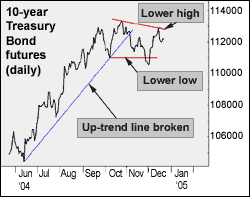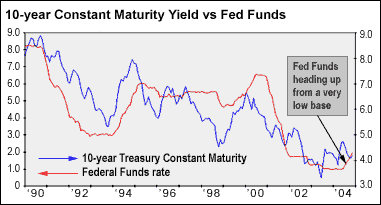Tuesday, December 27, 2005
Bond bubble, American-style
By Jack Crooks
Dec. 27, 2005
The past seldom obliges by revealing to us when wildness will break out in the future. Wars, depressions, stock-market booms and crashes, and ethnic massacres come and go, but they always seem to arrive as surprises. After the fact, however, when we study the history of what happened, the source of the wildness appears to be so obvious to us that we have a hard time understanding how people on the scene were oblivious to what lay wait for them. - Peter Bernstein, Against the Gods
We believe a nasty popping of the bond-market bubble lies in wait for investors. Why? In short, yields are too low, bond prices too high, and quality spreads too tight. The gargantuan rally, which actually peaked in June 2003, as evidenced in the monthly chart of 30-year bond futures below, should soon be history.
 The primary source of the "wildness" seems easy to pinpoint ahead of time - this time. It's the US Federal Reserve. It was the engineering of the emergency Fed Funds rate, to save the world from the clutches of deflation (denying this as the proper cleansing agent for economic sins past) that proved most impressive as bubble fuel. It's now the long march toward the elusive "normalization" of benchmark interest rates that will draw Zeppelin-like comparisons from observers as long-bond prices head toward earth.
The primary source of the "wildness" seems easy to pinpoint ahead of time - this time. It's the US Federal Reserve. It was the engineering of the emergency Fed Funds rate, to save the world from the clutches of deflation (denying this as the proper cleansing agent for economic sins past) that proved most impressive as bubble fuel. It's now the long march toward the elusive "normalization" of benchmark interest rates that will draw Zeppelin-like comparisons from observers as long-bond prices head toward earth.We wouldn't be surprised to see a surprise in the form of inflation scare, major hedge-fund collapse, or foreign bank reserve reallocation to hasten the descent of fixed income prices across the entire spectrum: from Treasury to junk. Those holding junk bonds, now the darling of yield chasers, will soon understand the moniker.
Here are a few tidbits of anecdotal evidence for your perusal:
* Net purchases of all US fixed-income securities rose to a record high in October on a rolling 12-month basis.
* Custody holdings of US debt hit a new high of US$1.329 trillion.
* Foreign purchases of US corporate bonds hit a record high on a rolling 12-month basis.
* Foreign purchases of US Agency paper hit a record high on a rolling 12-month basis.
* US high-yield, or junk, bond issuance has reached record levels; issuance to date totaled $139.8 billion, beating $136 billion in the previous year and just edging ahead of 1998's $137.8 billion.
* Interest-rate derivatives held by US commercial banks increased to a record $73 trillion (notional value) in the third quarter of 2004.
* The credit spreads on double- B-rated securities are tighter than they were on the eve of the Long Term Capital Management debacle.
* Strong investor demand for the debt has pushed the premium over Treasuries to historically low levels.
Sources: Thomson Financial, OCC Report, Financial Times, Weldon Money Monitor, Grant's
This historic level of love for bonds did give bonds a boost recently.
 But bond futures didn't reach the highs made in early 2004 and are well below record highs made in June 2003. Prices have stalled and are turning over. It appears as a classic technical pattern of a failed high, leading to a series of lower highs that will lead to a series of lower lows. The market now realizes the Fed is serious about hiking the Fed Funds rate. That, we believe, is why the price action is turning negative.
But bond futures didn't reach the highs made in early 2004 and are well below record highs made in June 2003. Prices have stalled and are turning over. It appears as a classic technical pattern of a failed high, leading to a series of lower highs that will lead to a series of lower lows. The market now realizes the Fed is serious about hiking the Fed Funds rate. That, we believe, is why the price action is turning negative.
There is a good chance that Fed Funds may rise more quickly than now believed. If the thinking at the Fed is anywhere close to that of Morgan Stanley economist Ted Wieseman, the rush out of bonds may morph to a stampede. "In an economy growing at a sustained 4%+ real rate, experiencing near-record low national savings, a corresponding record high current account gap and rising inflation, bubble seems the only reasonable way to describe real short rates of barely over 0%, real five-year rates of less than 1%, real 10-year rates of 1.6%, and real 20-year rates of less than 2%, probably 200 to 300 bp [basis points] below sustainable fair-value levels depending on maturity," writes Wieseman.
Many economists believe a hike in interest rates will improve the dismal US savings picture. "The net national savings rate has averaged 1.7% through the first three quarters of 2004, just above the record low of 1.2% hit in 2002," according to Wieseman. The structural dearth in savings rates adds to the US dependence on international investors for funding of the gaping twin deficits - the double-Ds of doom, so to speak. Thus higher rates will play a role in healing US and global "imbalances". This is the weighty justification the Fed will use for political cover.
The Fed's "policy mistake" was its decision to run the printing press 24/7 in order save the US economy from what it perceived as a Japan-style deflation. It was a conscious decision by the Fed to create asset bubbles rather than face the painfully healing music of recession. These asset bubbles and artificially lower interest rates have distorted consumer preferences. Instead of relying on genuine old-fashioned income growth to fund consumption, consumers have leveraged wealth off the stock and real-estate bubbles. And precisely because the yield on cash was at historic lows, both professional and not-so-professional investors quickly realized the advantages of borrowing short and lending long.
In other words, the Fed has engineered the largest one-way bet in history. The bet: long rates will stay low as far as the eye can see. Risk and uncertainty don't enter into the equation when there's such "easy" money to be made. What seems to be coming into focus is our "understanding how people on the scene" are "oblivious to what lay wait for them".
Reprinted by permission (Asia Times)

